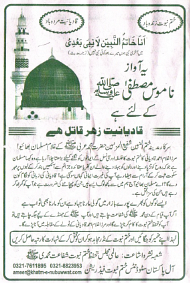The eternal question
June 06, 2010
A profile of Tehrik-e-Khatm-e-Nabuwat
By Waqar Gillani
The roots of Tehrik-e-Khatm-e-Nabuwat — the leading hardliner forum of Muslim clerics in Pakistan that is directed against the Ahmadiyya community — can be traced back to the 1880s when the Ahmadiyya school of thought was formally founded.
There are a number of religious forums of Muslim clerics but it was chiefly the Deoband school that launched the movement on the local as well as the international level, to corner Ahmadis not only in India but across the world.
The movement against Ahmadis gained momentum in 1934 when Majlis-e-Ahrar arranged a big gathering called Tahafuz-e-Khatm-e-Nabuwat Conference, held at Qadian, the headquarters of Ahmadis in the subcontinent. Attaullah Shah Bukhari of Majlis-e-Ahrar led the conference.
The movement’s history reads that after Pakistan came into being, as a result of the partition of the subcontinent, Chaudhry Zafarullah Khan, better known as Sir Zafarullah Khan, the first foreign minister of Pakistan, allegedly started patronising the Ahmadi sect and nurtured it using his office.
This was the first time that an all-parties movement to protect the finality of Prophet Muhammad (Peace be upon him) started to surface. This movement — eventually called Kul Jamaati Majlis-e-Aml Tahafuz-e-Khatm-e-Nabuwat — had three demands: a) removal of Zafarullah Khan from the foreign ministry; b) removal of Ahmadis from top government offices; and c) declaration of Ahmadis as non-Muslims. This was in 1949, when Majlis-e-Khatm-e-Nabuwat had just started working informally. The movement launched countrywide campaigns and protests resulting in a ban on Majlis-e-Ahrar in 1954. After the ban, a formal Majlis-e-Tahafuz-e-Khatm-e-Nabuwat emerged as the substitute to lead this anti-Ahmadi campaign. The clerics also launched Aalami Majlis-e-Tahafuz-e-Khatm-e-Nabuwat to counter Ahmadis across the world.
In 1973, the then president of Azad Jammu and Kashmir, Sardar Abdul Qayyum declared Ahmadis to be non-Muslims, a step which the Pakistani government had not yet taken. In the same year, Rabta-e-Alam-e-Islami Conference in Saudi Arabia also gave its stamp of approval to oust Ahmadis from the circle of Islam. The unfortunate beating of the students of Nishtar Medical College, Multan, on May 29, 1974, proved to be a major incident that infuriated this anti-Ahmadi movement. The students, going on train, started shouting against Ahmadis while reaching Rabwah – the headquarter city of Ahmadis in Pakistan – resulting in a strong reaction of Ahmadis to this gathering. The incident geared up the Khatm-e-Nabuwat movement that started a violent protest, finally bowing down the parliament to make law, declaring Ahmadis non-Muslims in December 1974. Leading clerics of the time like Mufti Mahmood Ahmed, Shah Ahmad Noorani, Professor Ghafoor Ahmed and many others participated in the 15-day debate on the parliament to declare Ahmadis non-Muslims. In 1976, the Khatm-e-Nabuwat people also set up a mosque and a seminary in the jurisdiction of Rabwah to show their impact.
After meeting the first agenda, Khatm-e-Nabuwat started the next phase of their campaign – to corner Ahmadis in Pakistan. They started demanding legal sanctions on Ahmadis barring them from using the title of Muslim. This campaign was at its peak when Maulana Yousaf of Jamia Banori, Karachi, and Punjab-based Maulana Khawaja Khan Muhammad (who died recently) were leading the Majlis-e-Amal Tahafuz-e-Khatam-e-Nabuwat in 1984 and 1985. The then dictator, General Ziaul Haq imposed legal sanctions on Ahmadis in 1984 through an ordinance barring them from using the title of Muslim, reading and reciting the Holy Quran, and stopping them to declare their worship places as mosque. The ordinance sections later became part of the Pakistan Penal Code (PPC), another target achieved by the Khatm-e-Nabuwat.
In 1985, Maulana Manzoor Ahmad Chinioti and Abdul Hafeez Makki and other clerics also launched a separate organisation titled International Khatm-e-Nabuwat Conference to further corner Ahmadis and force them to follow the legal sanctions of 1984.
In December 2009, another committee called Muttahida Tehrik-e-Khatm-e-Nabuwat Raabta Committee also surfaced in Lahore.
There are a number of religious forums of Muslim clerics but it was chiefly the Deoband school that launched the movement on the local as well as the international level, to corner Ahmadis not only in India but across the world.
The movement against Ahmadis gained momentum in 1934 when Majlis-e-Ahrar arranged a big gathering called Tahafuz-e-Khatm-e-Nabuwat Conference, held at Qadian, the headquarters of Ahmadis in the subcontinent. Attaullah Shah Bukhari of Majlis-e-Ahrar led the conference.
The movement’s history reads that after Pakistan came into being, as a result of the partition of the subcontinent, Chaudhry Zafarullah Khan, better known as Sir Zafarullah Khan, the first foreign minister of Pakistan, allegedly started patronising the Ahmadi sect and nurtured it using his office.
This was the first time that an all-parties movement to protect the finality of Prophet Muhammad (Peace be upon him) started to surface. This movement — eventually called Kul Jamaati Majlis-e-Aml Tahafuz-e-Khatm-e-Nabuwat — had three demands: a) removal of Zafarullah Khan from the foreign ministry; b) removal of Ahmadis from top government offices; and c) declaration of Ahmadis as non-Muslims. This was in 1949, when Majlis-e-Khatm-e-Nabuwat had just started working informally. The movement launched countrywide campaigns and protests resulting in a ban on Majlis-e-Ahrar in 1954. After the ban, a formal Majlis-e-Tahafuz-e-Khatm-e-Nabuwat emerged as the substitute to lead this anti-Ahmadi campaign. The clerics also launched Aalami Majlis-e-Tahafuz-e-Khatm-e-Nabuwat to counter Ahmadis across the world.
In 1973, the then president of Azad Jammu and Kashmir, Sardar Abdul Qayyum declared Ahmadis to be non-Muslims, a step which the Pakistani government had not yet taken. In the same year, Rabta-e-Alam-e-Islami Conference in Saudi Arabia also gave its stamp of approval to oust Ahmadis from the circle of Islam. The unfortunate beating of the students of Nishtar Medical College, Multan, on May 29, 1974, proved to be a major incident that infuriated this anti-Ahmadi movement. The students, going on train, started shouting against Ahmadis while reaching Rabwah – the headquarter city of Ahmadis in Pakistan – resulting in a strong reaction of Ahmadis to this gathering. The incident geared up the Khatm-e-Nabuwat movement that started a violent protest, finally bowing down the parliament to make law, declaring Ahmadis non-Muslims in December 1974. Leading clerics of the time like Mufti Mahmood Ahmed, Shah Ahmad Noorani, Professor Ghafoor Ahmed and many others participated in the 15-day debate on the parliament to declare Ahmadis non-Muslims. In 1976, the Khatm-e-Nabuwat people also set up a mosque and a seminary in the jurisdiction of Rabwah to show their impact.
After meeting the first agenda, Khatm-e-Nabuwat started the next phase of their campaign – to corner Ahmadis in Pakistan. They started demanding legal sanctions on Ahmadis barring them from using the title of Muslim. This campaign was at its peak when Maulana Yousaf of Jamia Banori, Karachi, and Punjab-based Maulana Khawaja Khan Muhammad (who died recently) were leading the Majlis-e-Amal Tahafuz-e-Khatam-e-Nabuwat in 1984 and 1985. The then dictator, General Ziaul Haq imposed legal sanctions on Ahmadis in 1984 through an ordinance barring them from using the title of Muslim, reading and reciting the Holy Quran, and stopping them to declare their worship places as mosque. The ordinance sections later became part of the Pakistan Penal Code (PPC), another target achieved by the Khatm-e-Nabuwat.
In 1985, Maulana Manzoor Ahmad Chinioti and Abdul Hafeez Makki and other clerics also launched a separate organisation titled International Khatm-e-Nabuwat Conference to further corner Ahmadis and force them to follow the legal sanctions of 1984.
In December 2009, another committee called Muttahida Tehrik-e-Khatm-e-Nabuwat Raabta Committee also surfaced in Lahore.









